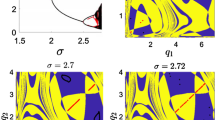Abstract
In this paper, we propose an oligopoly model where each firm can produce with linear costs up to its “maximum efficient scale” level and then it incurs quadratic costs for the production exceeding that level. As a consequence, the discrete dynamic model of firms’ choices over time is expressed by a piecewise-smooth map. For this model, we show how border collision bifurcations are responsible of the main qualitative changes in the dynamic of the system. In particular, employing specific numerical examples, we explain the basic mechanism of creation/destruction of periodic points and limit cycles through border crossings as the parameters of the model are changed.
Similar content being viewed by others
References
Agliari A., Bischi G.I., Gardini L. (2002) Some methods for the global analysis of dynamic games represented by noninvertible maps. In: Puu T., Sushko I. (eds) Chapter 3 in Oligopoly dynamics: Models and tools. Springer, Heidelberg
Agliari A., Gardini L., Puu T. (2006) Global bifurcations in duopoly when the Cournot point is destabilized via a subcritical Neimark bifurcation. International Game Theory Review 8(1): 1–20
Banerjee S., Karthik M. S., Yuan G., Yorke J. A. (2000) Bifurcations in one-dimensional piecewise smooth maps—Theory and applications in switching circuits. IEEE Transactions on Circuits Systems—I: Fundamental Theory and Applications 47(3): 389–394
Banerjee S., Ranjan P., Grebogi C. (2000) Bifurcations in two-dimensional piecewise smooth maps—Theory and applications in switching circuits. IEEE Transactions on Circuits Systems—I: Fundamental Theory and Applications 47(5): 633–643
Bertsekas D. (1999) Nonlinear programming (2nd ed.). Belmount, Athena
Bischi G. I., Chiarella C., Kopel M., Szidarovszky F. (2010) Nonlinear oligopolies: Stability and bifurcations. Springer, Berlin
Bischi, G. I., & Lamantia, F. (2011). Routes to complexity induced by constraints in Cournot oligopoly games with linear reaction functions, Studies in Nonlinear Dynamics and Econometrics, in press.
Dana R. A., Montrucchio L. (1986) Dynamic complexity in duopoly games. Journal of Economic Theory 40: 40–56
Di Bernardo M., Budd C. J., Champneys A. R., Kowalczyk P. (2008) Piecewise-smooth dynamical systems. Springer, London, UK
Horiba Y., Tsutsui S. (2000) International duopoly, tariff policies and the case of free trade. Japanese Economic Review 51: 207–220
Karamardian, S. (1969). The nonlinear complementarity problem with applications. Journal of Optimization Theory and Applications, 4, Part I, 87–98; Part II, 167–181.
Lambertini L. (2010) Oligopoly with hyperbolic demand: A differential game approach. Journal of Optimization Theory and Applications 145: 108–119
Laugesen J., Mosekilde E. (2006) Border-collisions in a dynamic management game. Computers & Operations Research 33: 464–478
Lu Y., Poddar S. (2005) Mixed oligopoly and the choice of capacity. Research in Economics 59: 365–374
Maggi G. (1996) Strategic trade policies with endogenous mode of competition. The American Economic Review 86(1): 237–258
Mira C., Gardini L., Barugola A., Cathala J. C. (1996) Chaotic dynamics in two-dimensional noninvertible maps. World Scientific, Singapore
Mosekilde E., Zhusubaliyev Z. T. (2003) Bifurcations and chaos in piecewise-smooth dynamical systems. World Scientific, Singapore
Nusse H. E., Yorke J. A. (1992) Border-collision bifurcations including period two to period three for piecewise smooth systems. Physica D 57: 39–57
Puu T. (1991) Chaos in duopoly pricing. Chaos, Solitons & Fractals 1(6): 573–581
Puu T. (2010) Unifying Cournot and Stackelberg action in a dynamic setting. In: Bischi G. I., Chiarella C., Gardini L. (eds) Nonlinear dynamics in economics, finance and the social sciences. Springer, Berlin, pp 117–138
Puu T. (2011) Oligopoly old ends—New means. Springer, Berlin
Puu T., Norin A. (2003) Cournot duopoly when the competitors operate under capacity constraints. Chaos, Solitons & Fractals 18: 577–592
Rand D. (1978) Exotic phenomena in games and duopoly models. Journal of Mathematical Economics 5: 173–184
Tirole J. (2000) The theory of industrial organization. MIT press, Cambridge, MA
Tramontana F., Gardini L., Puu T. (2010) Global bifurcations in a piecewise-smooth Cournot Duopoly game. Chaos, Solitons & Fractals 43: 15–24
Tramontana F., Gardini L., Puu T. (2011) Mathematical properties of a discontinuous Cournot-Stackelberg model. Chaos, Solitons & Fractals 44: 58–70
Vedenov D. V., Miranda M. J. (2001) Numerical solution of dynamic oligopoly games with capital investment. Economic Theory 18: 237–261
Vives X. (2001) Oligopoly pricing. MIT Press, Cambridge, MA
Vives X. (1986) Commitment, flexibility and market outcomes. International Journal of Industrial Organization 4: 217–229
Author information
Authors and Affiliations
Corresponding author
Rights and permissions
About this article
Cite this article
Lamantia, F. A Nonlinear Duopoly with Efficient Production-Capacity Levels. Comput Econ 38, 295–309 (2011). https://doi.org/10.1007/s10614-011-9280-0
Accepted:
Published:
Issue Date:
DOI: https://doi.org/10.1007/s10614-011-9280-0




